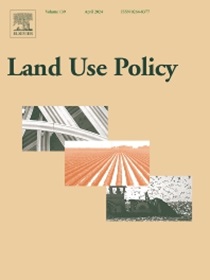How would urban green spaces diverge under different development strategies? Comparison between Shenzhen and Zhuhai
IF 5.9
1区 社会学
Q1 ENVIRONMENTAL STUDIES
引用次数: 0
Abstract
Urban development strategies significantly shape the characteristics of urban green spaces (UGS). It remains unclear how UGS outcomes differ across cities that have followed distinct strategic trajectories. With this paper, we enrich the environmental justice debate by investigating differences in the provision of UGS resulting from different development strategies, focusing on three dimensions: availability, accessibility, and attractiveness. We choose Shenzhen and Zhuhai as study areas, as they shared similar conditions in 1980 but have significantly diverged in development trajectories over the past four decades. Specifically, by employing multi-source data, in combination with deep learning models and GIS methods, we quantify the availability, accessibility, and attractiveness of UGS. We then conduct a comprehensive comparison and analysis across these dimensions. The findings reveal substantial disparities between the cities in UGS availability, accessibility and attractiveness. Notably, the availability and accessibility of UGS in Shenzhen are more equitable than expected, despite its lower overall green space coverage. Conversely, Zhuhai, though characterized by higher UGS coverage and accessibility, exhibits significant inequalities in both aspects. The attractiveness of UGS in Shenzhen is found to be higher than in Zhuhai. In Zhuhai, UGS areas with greater sky openness tend to be perceived as more attractive, while in Shenzhen, locations with higher green visibility are more appealing. Rather than establishing causal links, this study highlights outcome differences in UGS provision under different development contexts. The comparative findings from Shenzhen and Zhuhai provide empirically grounded insights for urban strategy formulation, particularly for balancing economic development with spatial equity and environmental well-being.
在不同的发展策略下,城市绿地会有怎样的分化?深圳与珠海比较
城市发展战略在很大程度上塑造了城市绿地的特征。目前尚不清楚UGS的结果在遵循不同战略轨迹的城市之间有何不同。在本文中,我们通过调查不同发展战略导致的UGS提供差异,重点关注三个维度:可得性、可及性和吸引力,从而丰富了环境正义的辩论。我们之所以选择深圳和珠海作为研究区域,是因为这两个城市在1980年的情况相似,但在过去40年的发展轨迹却大相径庭。具体而言,通过采用多源数据,结合深度学习模型和GIS方法,我们量化了UGS的可用性、可访问性和吸引力。然后,我们对这些维度进行全面的比较和分析。调查结果显示,城市之间在UGS的可用性、可及性和吸引力方面存在巨大差异。值得注意的是,尽管深圳的总体绿地覆盖率较低,但UGS的可用性和可达性比预期的更公平。相反,珠海虽然具有较高的UGS覆盖率和可达性,但在这两个方面都表现出明显的不平等。研究发现,深圳UGS的吸引力高于珠海。在珠海,天空更开放的UGS区域往往被认为更具吸引力,而在深圳,绿色能见度更高的地点更有吸引力。这项研究并没有建立因果关系,而是强调了不同发展背景下UGS提供的结果差异。深圳和珠海的对比研究结果为城市战略制定提供了经验基础的见解,特别是在平衡经济发展与空间公平和环境福祉方面。
本文章由计算机程序翻译,如有差异,请以英文原文为准。
求助全文
约1分钟内获得全文
求助全文
来源期刊

Land Use Policy
ENVIRONMENTAL STUDIES-
CiteScore
13.70
自引率
8.50%
发文量
553
期刊介绍:
Land Use Policy is an international and interdisciplinary journal concerned with the social, economic, political, legal, physical and planning aspects of urban and rural land use.
Land Use Policy examines issues in geography, agriculture, forestry, irrigation, environmental conservation, housing, urban development and transport in both developed and developing countries through major refereed articles and shorter viewpoint pieces.
 求助内容:
求助内容: 应助结果提醒方式:
应助结果提醒方式:


